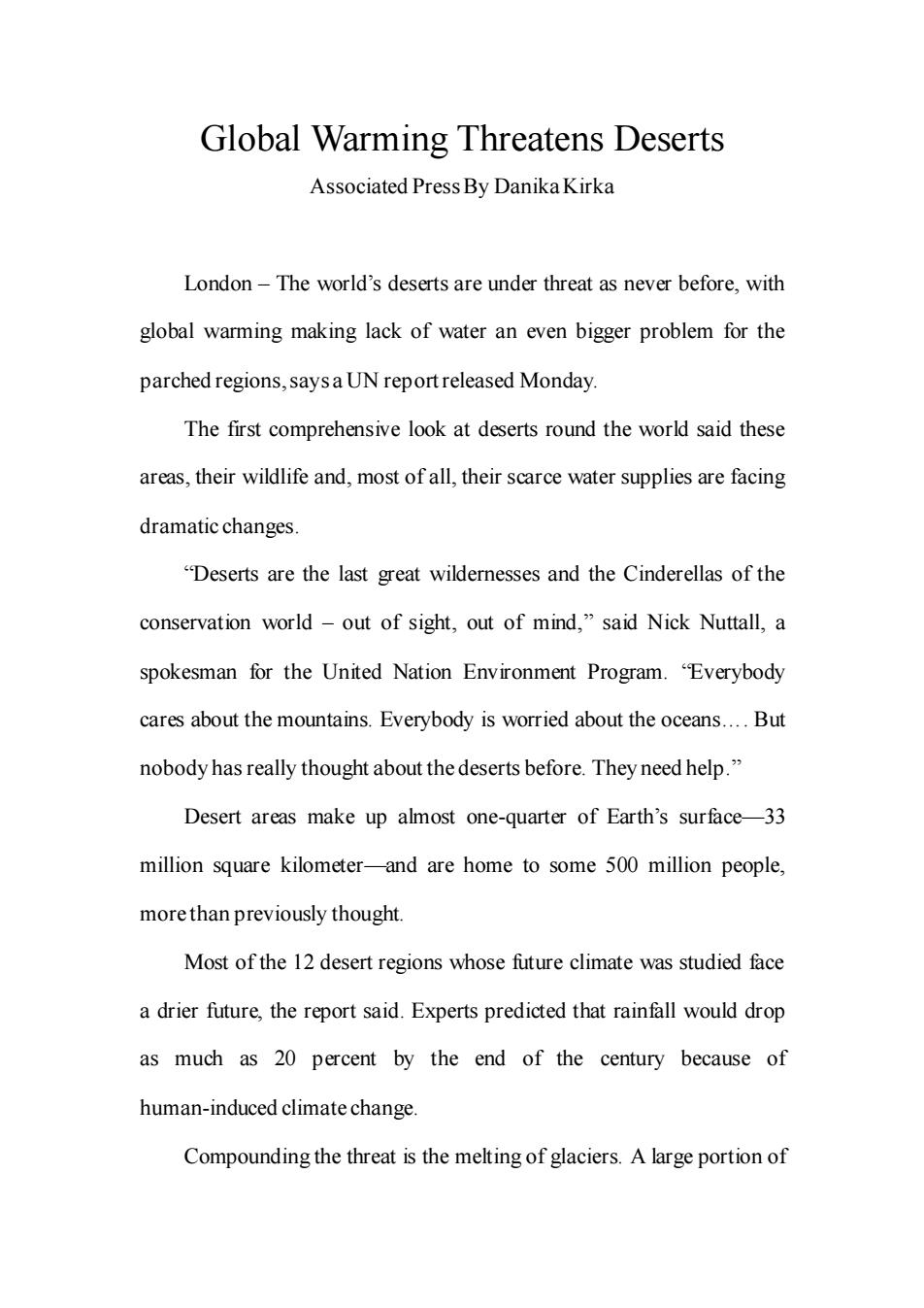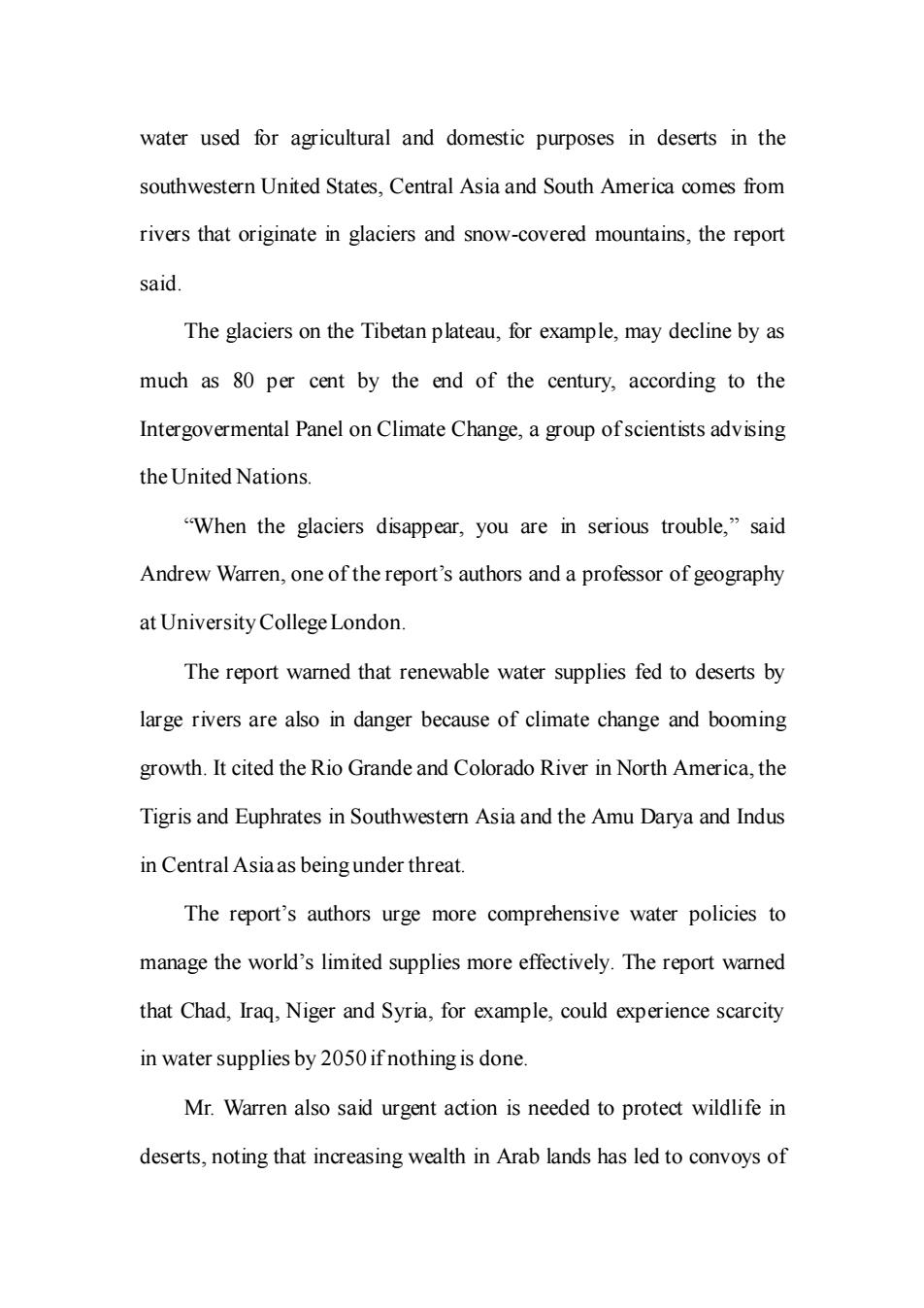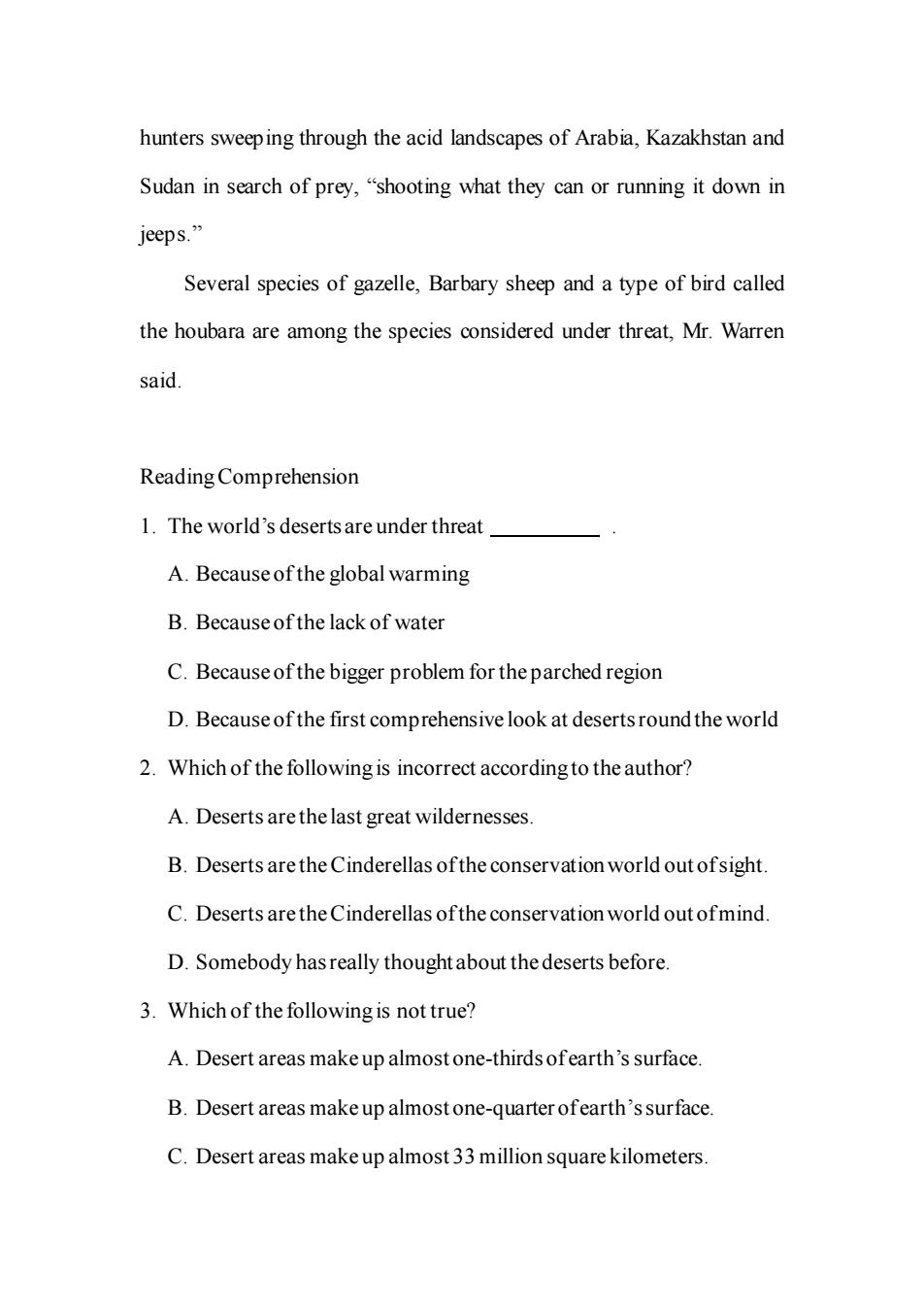
Global Warming Threatens Deserts Associated Press By Danika Kirka London-The world's deserts are under threat as never before,with global warming making lack of water an even bigger problem for the parched regions,saysaUN reportreleased Monday. The first comprehensive look at deserts round the world said these areas,their wildlife and,most of all,their scarce water supplies are facing dramatic changes "Deserts are the last great wildernesses and the Cinderellas of the conservation world-out of sight,out of mind,"said Nick Nuttall,a spokesman for the United Nation Environment Program."Everybody cares about the mountains.Everybody is worried about the oceans....But nobody has really thought about the deserts before.They need help." Desert areas make up almost one-quarter of Earth's surface-33 million square kilometer-and are home to some 500 million people, more than previously thought. Most of the 12 desert regions whose future climate was studied face a drier future,the report said.Experts predicted that rainfall would drop as much as 20 percent by the end of the century because of human-induced climate change. Compounding the threat is the melting of glaciers.A large portion of
Global Warming Threatens Deserts Associated Press By Danika Kirka London – The world’s deserts are under threat as never before, with global warming making lack of water an even bigger problem for the parched regions, says a UN report released Monday. The first comprehensive look at deserts round the world said these areas, their wildlife and, most of all, their scarce water supplies are facing dramatic changes. “Deserts are the last great wildernesses and the Cinderellas of the conservation world – out of sight, out of mind,” said Nick Nuttall, a spokesman for the United Nation Environment Program. “Everybody cares about the mountains. Everybody is worried about the oceans…. But nobody has really thought about the deserts before. They need help.” Desert areas make up almost one-quarter of Earth’s surface—33 million square kilometer—and are home to some 500 million people, more than previously thought. Most of the 12 desert regions whose future climate was studied face a drier future, the report said. Experts predicted that rainfall would drop as much as 20 percent by the end of the century because of human-induced climate change. Compounding the threat is the melting of glaciers. A large portion of

water used for agricultural and domestic purposes in deserts in the southwestern United States.Central Asia and South America comes from rivers that originate in glaciers and snow-covered mountains,the report said The glaciers on the Tibetan plateau,for example,may decline by as much as 80 per cent by the end of the century,according to the Intergovermental Panel on Climate Change,a group ofscientists advising the United Nations. "When the glaciers disappear,you are in serious trouble,"said Andrew Warren,one of the report's authors and a professor of geography at University College London. The report warned that renewable water supplies fed to deserts by large rivers are also in danger because of climate change and booming growth.It cited the Rio Grande and Colorado River in North America,the Tigris and Euphrates in Southwestern Asia and the Amu Darya and Indus in Central Asiaas being under threat. The report's authors urge more comprehensive water policies to manage the world's limited supplies more effectively.The report warned that Chad,Iraq,Niger and Syria,for example,could experience scarcity in water supplies by 2050 if nothing is done Mr.Warren also said urgent action is needed to protect wildlife in deserts,noting that increasing wealth in Arab lands has led to convoys of
water used for agricultural and domestic purposes in deserts in the southwestern United States, Central Asia and South America comes from rivers that originate in glaciers and snow-covered mountains, the report said. The glaciers on the Tibetan plateau, for example, may decline by as much as 80 per cent by the end of the century, according to the Intergovermental Panel on Climate Change, a group of scientists advising the United Nations. “When the glaciers disappear, you are in serious trouble,” said Andrew Warren, one of the report’s authors and a professor of geography at University College London. The report warned that renewable water supplies fed to deserts by large rivers are also in danger because of climate change and booming growth. It cited the Rio Grande and Colorado River in North America, the Tigris and Euphrates in Southwestern Asia and the Amu Darya and Indus in Central Asia as being under threat. The report’s authors urge more comprehensive water policies to manage the world’s limited supplies more effectively. The report warned that Chad, Iraq, Niger and Syria, for example, could experience scarcity in water supplies by 2050 if nothing is done. Mr. Warren also said urgent action is needed to protect wildlife in deserts, noting that increasing wealth in Arab lands has led to convoys of

hunters sweeping through the acid landscapes of Arabia,Kazakhstan and Sudan in search of prey,"shooting what they can or running it down in Jeeps.” Several species of gazelle,Barbary sheep and a type of bird called the houbara are among the species considered under threat,Mr.Warren said. Reading Comprehension 1.The world's desertsare under threat A.Becauseofthe global warming B.Becauseofthe lack of water C.Becauseofthe bigger problem for the parched region D.Becauseofthe first comprehensive look at desertsround the world 2.Which of the following is incorrect accordingto the author? A.Deserts are the last great wildernesses B.Deserts are the Cinderellas ofthe conservation world out ofsight. C.Deserts are the Cinderellas ofthe conservation world out ofmind. D.Somebody hasreally thoughtabout the deserts before. 3.Which of the following is not true? A.Desert areas makeup almostone-thirds ofearth's surface B.Desert areas make up almost one-quarter ofearth's surface. C.Desert areas make up almost 33 million square kilometers
hunters sweeping through the acid landscapes of Arabia, Kazakhstan and Sudan in search of prey, “shooting what they can or running it down in jeeps.” Several species of gazelle, Barbary sheep and a type of bird called the houbara are among the species considered under threat, Mr. Warren said. Reading Comprehension 1. The world’s deserts are under threat . A. Because of the global warming B. Because of the lack of water C. Because of the bigger problem for the parched region D. Because of the first comprehensive look at deserts round the world 2. Which of the following is incorrect according to the author? A. Deserts are the last great wildernesses. B. Deserts are the Cinderellas of the conservation world out of sight. C. Deserts are the Cinderellas of the conservation world out of mind. D. Somebody has really thought about the deserts before. 3. Which of the following is not true? A. Desert areas make up almost one-thirds of earth’s surface. B. Desert areas make up almost one-quarter of earth’s surface. C. Desert areas make up almost 33 million square kilometers

D.Desert areas are hometo some 500 million people 4.What is true accordingto the UN report? A.Compounding the threat is the melting of glaciers. B.A Large portion of water used for agriculture is coming from the river. C.A large portion of water used for domestic purpose is coming from snow-covered mountains. D.Most of 12 desert regions whose future will face a die future. 5.The report's authors urge more comprehensive water policies to manage the world's limited supplies more effectively,because that A.renewable water supplies fed to deserts by large rivers are also in danger B.the Rio Grande and Colorado River in North America the Tigris and Euphrates in Southwestern Asia and the Amu Darya and Indus in Central Asiaas being under threat C.Chad,Iraq,Niger and Syria could experience scarcity in water supplies by 2050 ifnothing is done D.All oftheabove. 6.Urgent action is needed to protect wildlife in deserts because_ A.Wildlife in deserts area are fewer and fewer
D. Desert areas are home to some 500 million people. 4. What is true according to the UN report? A. Compounding the threat is the melting of glaciers. B. A Large portion of water used for agriculture is coming from the river. C. A large portion of water used for domestic purpose is coming from snow-covered mountains. D. Most of 12 desert regions whose future will face a die future. 5. The report’s authors urge more comprehensive water policies to manage the world’s limited supplies more effectively, because that . A. renewable water supplies fed to deserts by large rivers are also in danger B. the Rio Grande and Colorado River in North America the Tigris and Euphrates in Southwestern Asia and the Amu Darya and Indus in Central Asia as being under threat C. Chad, Iraq, Niger and Syria could experience scarcity in water supplies by 2050 if nothing is done D. All of the above. 6. Urgent action is needed to protect wildlife in deserts because . A. Wildlife in deserts area are fewer and fewer

B.Hunters are shooting what they can or running it down in jeeps in search ofprey in deserts area C.Several species of gazelle,barbary sheep a type of bird called the houbaraare among thespecies considered threat D.All oftheabove
B. Hunters are shooting what they can or running it down in jeeps in search of prey in deserts area C. Several species of gazelle, barbary sheep a type of bird called the houbara are among the species considered threat D. All of the above